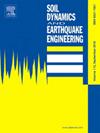The incompatible deformation mechanism of underground tunnels crossing fault conditions in the southwest edge strong seismic zone of the Qinghai-Tibet Plateau: A study of shaking table test
IF 4.6
2区 工程技术
Q1 ENGINEERING, GEOLOGICAL
引用次数: 0
Abstract
The study of the seismic damage mechanism of tunnels subjected to strong earthquakes is challenging frontier subjects. In strong earthquake areas, the survey and line selection design of tunnels and underground engineering avoid the identification of dense fault areas and large major fault fracture zones, but the active fault fracture zone, which is widely distributed, large depth and difficult to detect in location, is still at a loss. Due to seismic loadings, the dynamic response and failure mechanism of the surrounding rock are always unclear. This study involved on-site investigations and indoor shaking table tests to demonstrate how seismic activity affects the hanging wall, footwall, and fault during vibration processes as part of the Xianglushan tunnel major project. Additionally, we explored how these elements interact with each other despite their incompatible deformation laws. The incompatible deformation effect of the dynamic tensile-compressive deformation effort and dynamic shear deformation effort were proposed. The quantitative description of dynamic uncoordinated deformation was given based on the wave function. In addition, the mechanism of dynamic deformation failure of the surrounding rock of tunnel was revealed by comparing the test results to the engineering site's deformation failure pattern. Experimental results show that the acceleration peak, strain peak and displacement time curve had obvious amplified effects in the horizontal and vertical directions, and the Fourier amplitude was shown as a consistent rule of change by the shaking table tests. The hanging wall and lower disks of the fault have obvious incompatible and inconsistent deformation effects, the vertical vibratory direction is represented by dynamic tensile-compressive deformation, and the horizontal vibratory direction is represented by dynamic shear deformation. The incompatible deformation theory and the wave function were introduced to reveal the dynamic failure mechanism of the surrounding rock across a fault combined with the deformation failure of the seismic tunnel site and shaking table test. The dynamic incompatible deformation caused by internal defects was accelerated by strong seismic activity. The dynamic destruction process of the surrounding rock of tunnel was the gradual failure process caused by stress damage accumulated in the rock surrounding the tunnel. The results can provide reference and data support for the safe construction of tunnels under complex geological conditions of dense faults in strong earthquake areas.

青藏高原西南缘强震带地下隧道穿越断层条件的不相容变形机制——振动台试验研究
隧道在强震作用下的震害机理研究是具有挑战性的前沿课题。在强震地区,隧道和地下工程的勘察选线设计避免了对密集断裂带和大型主要断裂断裂带的识别,但对分布广、深度大、定位难探测的活动断裂断裂带仍是茫然的。由于地震荷载的作用,围岩的动力响应和破坏机制一直不清楚。本研究采用现场调查和室内振动台试验的方法,论证了在振动过程中,地震活动对上盘、下盘和断层的影响。此外,我们探索了这些元素如何相互作用,尽管他们不相容的变形规律。提出了动态拉压变形力和动态剪切变形力的不相容变形效应。基于波函数给出了动态不协调变形的定量描述。并将试验结果与工程现场的变形破坏模式进行对比,揭示了隧道围岩动力变形破坏的机理。实验结果表明,加速度峰值、应变峰值和位移时间曲线在水平方向和垂直方向上都有明显的放大效应,且振动台试验显示傅里叶幅值具有一致的变化规律。断层上盘和下盘具有明显的不相容和不一致变形效应,垂直振动方向以动态拉压变形为特征,水平振动方向以动态剪切变形为特征。引入不相容变形理论和波函数,结合地震隧洞现场变形破坏和振动台试验,揭示了围岩跨断层的动力破坏机制。强烈的地震活动加速了由内部缺陷引起的动力不协调变形。隧道围岩的动力破坏过程是应力损伤在隧道围岩中积累而形成的逐渐破坏过程。研究结果可为强震地区断层密集复杂地质条件下隧道的安全施工提供参考和数据支持。
本文章由计算机程序翻译,如有差异,请以英文原文为准。
求助全文
约1分钟内获得全文
求助全文
来源期刊

Soil Dynamics and Earthquake Engineering
工程技术-地球科学综合
CiteScore
7.50
自引率
15.00%
发文量
446
审稿时长
8 months
期刊介绍:
The journal aims to encourage and enhance the role of mechanics and other disciplines as they relate to earthquake engineering by providing opportunities for the publication of the work of applied mathematicians, engineers and other applied scientists involved in solving problems closely related to the field of earthquake engineering and geotechnical earthquake engineering.
Emphasis is placed on new concepts and techniques, but case histories will also be published if they enhance the presentation and understanding of new technical concepts.
 求助内容:
求助内容: 应助结果提醒方式:
应助结果提醒方式:


